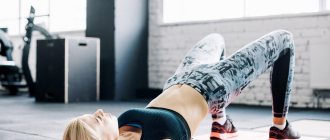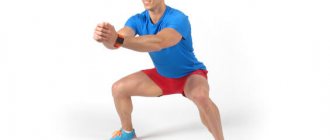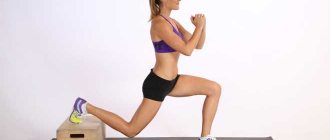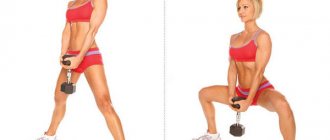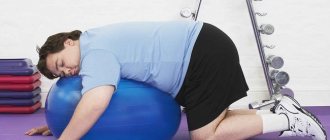Rules for performing the exercise
- Stand up straight, take two dumbbells, keep your arms along your body.
- Step forward with your right foot about 60 cm, leave your left foot motionless behind, keep your back straight. Maintain an upright body position to maintain balance. Take a breath as you step. Caution: Do not allow your knees to lean toward your toes to avoid putting undue stress on the knee joint. Make sure your shins are perpendicular to the ground.
- Push up, focusing on your heel, and return to the starting position as you exhale.
- Repeat the exercise the recommended number of times, then do it on your left leg.
Variations : There are several ways to perform this exercise.
Stand straight, hold dumbbells in your hands along your body. As you inhale, take a step forward, lowering your upper body. As you exhale, push up with your heel and return to the starting position. The exercise can be performed alternately with each leg, with dumbbells or a barbell, or with a walk-through.
What muscles work when performing lunges with dumbbells?
Conventionally, the muscles involved can be divided into two groups: main and auxiliary.
Main muscles:
- Gluteus maximus;
- External and lateral heads of the quadriceps;
- Biceps femoris muscle.
Auxiliary:
- Gluteus minimus and medius muscles;
- Abdominal muscles;
- Semitendinosus and semimembranosus (back of the thigh) muscles;
- Spinal extensor muscles;
- Adductor muscles of the thighs;
- Calf muscles.
It is worth noting that a static load is applied to the arm muscles.
Benefits of Exercise
This movement has many useful bonuses:
- Lunges belong to a group of exercises that involve asymmetrical leg work. Thanks to this, imbalances in each can be eliminated.
- It can be done at home.
- Lots of variations. Each version of the exercise has its own advantages. In addition, you can combine several variations in one workout.
- Exercise has a positive effect on the development of small stabilizer muscles, and also develops and improves coordination.
- Lunges with dumbbells do not create a strong load on the lumbar region. They can be used as an alternative to barbell exercises.
Working muscles
Dumbbell lunges and barbell lunges are great core leg exercises that work the quadriceps, hamstrings, glutes, back, and give you a clear feel for which muscles are being worked.
The exercise helps to pump up the buttocks and thighs very well - to give them relief and work out all the other muscles. In addition, the exercise is perfect for many sports where coordination, balance and explosive power are needed, for example, athletics, martial arts, cycling.
Canadian Doug Proden set 9 world and 13 national fitness records. He did 5,557 push-ups in 3 hours, 2 minutes, 30 seconds and did 667 one-arm push-ups in an hour. His achievements are listed in the Guinness Book of Records and the Book of Alternative Records.
Basic
If we analyze which muscles work during lunges with dumbbells, we get the following picture:
- The quadriceps is one of the two main working groups. This muscle extends the limb at the knee joint when we rise from the lowest point.
- Lunges with dumbbells are great for the buttocks - along with the quadriceps, they experience significant stress when extending the hip when lifting up.
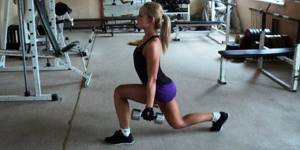
Additional
In addition to the quadriceps and gluteus maximus, the following muscles take part in the work: the abdominal muscles, gluteus medius, hamstrings, back muscles, calf muscles, etc. The main function of the listed muscles in this exercise is to stabilize the position of the body and legs.
It’s not for nothing that the movement is called coordination complex - it’s true that maintaining balance is not always possible the first time. You can also mention the arm muscles with which you hold dumbbells - they work statically .
By varying the width of the step when performing the exercise, you can shift the load towards the buttocks or towards the quadriceps:
- The step is wider, the supporting limb has an angle at the knee of more than 90 degrees - the gluteal muscle stretches better and works more. This is the best option for most girls. However, the wider your feet are, the less comfortable it is to step and walk back.
- The step is narrower, the supporting leg is bent at a right angle - the front surface of the thigh is more involved.
Technique options with dumbbells
Dumbbells are your most versatile equipment, with which you can diversify your workout in terms of difficulty level and quality of body work.
Lunges with dumbbells forward
Stand up straight, take dumbbells in your hands, lower your arms along your body. As you inhale, take a step forward, lowering your upper body. Keep your body straight and your shins perpendicular to the floor. As you exhale, push up and return to the starting position. Repeat the recommended number of times.
Lunges with dumbbells forward
Lunges with dumbbells back
Stand up straight, take dumbbells in your hands, lower your arms along your body. As you inhale, take a step back, lowering your upper body. Keep your body straight and your shins perpendicular to the floor. As you exhale, push up and return to the starting position. Repeat the recommended number of times.
Lunges with dumbbells back

Lunges with dumbbells
A more difficult method is Lunges with walking, when you move around the room or hall in this way. This method is suitable for more experienced athletes.
Hold dumbbells in both hands while maintaining balance. Lunge forward. The knee of the back leg almost touches the floor. Keep your back straight. Push off with the heel of your front foot, rise back up and step forward with the other leg, repeating the lunge.
Bodyweight walking lunges
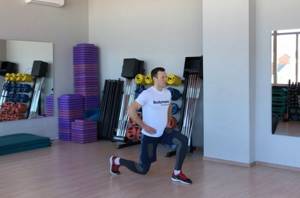
Walking Lunges with Dumbbells Overhead
Lunges can also be done while holding weights on your hands to maximize the load on the stabilizer muscles of the shoulder girdle and core. This option is more suitable for professionals who have already mastered this exercise and do not have problems with balance in movement.
Hold the barbell at arm's length. Lunge forward. The knee of the back leg almost touches the floor. Keep your back straight. Push off with the heel of your front foot, rise back up and step forward with the other leg, repeating the lunge.
Walking lunges with barbell overhead
Lunges with a dumbbell under your foot
Lunges are a basic and versatile exercise for the lower body. Kettlebell lunges also allow you to train balance and stability. When performing this exercise, all the muscles of the torso work.
Lunges with weights under the foot
Back scissor lunges with dumbbells
Cross lunges allow you to effectively work your gluteal muscles. Thanks to the crossed position of the legs, similar in technique to a curtsey, the gluteal muscle receives an excellent stretch in the lower phase of the movement. Performing this exercise with dumbbells, a barbell, or even no weight at all allows you to create rounded, toned buttocks, visually lifting them and separating them from the hamstrings.
Back lunges into scissors with weight
Bulgarian split squats with dumbbells
Stand up straight, hold the weight plate in front of you at chest level. Place one leg on a hill. As you inhale, perform a squat, keeping your body motionless. As you exhale, return to the starting position. Perform the required number of times and change legs.
Bulgarian split squats with weight
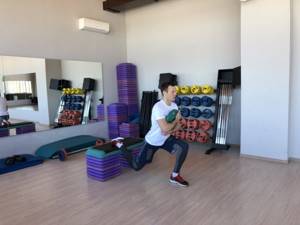
Lunges with dumbbells on a bosu platform
In order to correctly perform the exercise on the bosu platform, take the starting position, and then step on the center of the hemisphere with your working leg and lunge. Be sure to focus on your heel. The back leg rests on the toe. As in the classic version of the exercise, the legs are bent at a right angle.
It is recommended to perform the exercise first on one leg and then on the other leg. To make it more challenging, you can perform reverse lunges on the Bosu platform.
Contraindications and precautions
Like other types of lunges, lunges with dumbbells always put a lot of stress on the knee joints. In this regard, they are considered more traumatic than, for example, squats. This can be explained by the fact that when squats, the weight of the body and weights is distributed on both legs, but when lunges, only one leg receives the entire load. This is good for the muscles, but ligaments and joints, especially if they are weak, may suffer.

Consider contraindications . You should not do lunges with dumbbells if you have recently suffered knee injuries. If they were, but a long time ago, be careful when performing the exercise. Do not give yourself too much stress and, if you feel even a little discomfort, stop physical activity. In addition, in how to properly do lunges with dumbbells, it is important to consider the following points:
- Before you start training, be sure to warm up your muscles so that joint lubrication (synovial fluid) is released. This will help prevent injury, prepare your muscles for stress, and allow you to warm up. Squats, rotations of the feet and legs, bending, jumping, and so on are suitable as a warm-up. It is enough to spend five minutes on this.
- If you are using heavy weights, you should not do steps. That is, it is better for both legs to remain in place. In this case, lunges are transformed into slightly different exercises - scissor squats.
- If you haven't done lunges before, it's best to first master your technique without using weights.
- During the exercise, if you feel pain, discomfort and other signals that are a deviation from the norm, it is better to finish the exercise.
- While doing the exercises, try not to look down, otherwise it will be more difficult for you to maintain your balance.
- The back leg serves precisely to maintain balance. Don't push against it or put all your weight on it.
- Pay attention to your breathing. Lower as you exhale, rise as you inhale. Don't hold your breath for too long.
- The angle of your bent legs should be approximately 90 degrees.
- When learning how to do lunges with dumbbells, it is important to keep your body straight, without leaning excessively forward or falling back.
- When rising, lean not on your toes, but on the heel of your active leg. You should not start your lift with a push from your supporting leg. In this case, the load on the hips will be significantly reduced, and the exercise will become less effective.
- Take fairly wide steps. With small steps, the knee may go beyond the toe of the working leg, and this will cause stress on the knee joint. Accordingly, the risk of injury will increase.
- If you want to make the exercise more difficult, you can replace the dumbbells with a barbell. In this case, the coordination and stabilization effect will be better. But as far as targeted pumping of the quadriceps is concerned, dumbbells are still more suitable. Their weight should be sufficient. If it is difficult to hold them, be sure to use straps.
- You can complicate the exercise by performing repetitions not one by one, but first the required number of times with one leg, and then with the other.
If lunges are not suitable for you due to knee problems, you can replace this exercise with swings back, forward and to the sides. You can do this using a special simulator or on a lower block. To work out the buttocks, you can use the gluteal bridge. But in any case, each injury is individual, so there is no universal advice, and it is better to consult a specialist.
Bodymaster.ru recommends Fitness Trainers:
The main mistakes when doing lunges with dumbbells include:
- "Round back" Your back should be kept straight while performing lunges. The gaze is directed in front of you or slightly upward.
- Tilt of the body towards the front leg. As in the note above, the back should be straight, shoulders down, gaze forward.
- The knee of the working leg (front) “crawls out” beyond the line of the foot. We should not forget that the thigh and lower leg should form a right angle.
- Push with the back leg while lifting. The main load should be placed on the working leg. When performed correctly, the push is carried out by the heel of the front foot.
- Feet on the same line. With this position of the feet, it is very difficult to maintain the correct technique and maintain balance.

Exercise options
It’s best to alternate classic forward lunges with dumbbells with other lunge variations that will help provide a more varied load. There are such exercise options:
- Back lunges. In this case, you will need to step not with your working leg forward, but with your supporting leg and back. In this case, there will be no moment of lowering the foot of the working leg to the floor, and this will help reduce the load on the joints. However, the working leg will be constantly under tension, and unlike the classical variation, it will not be unloaded until the end of the exercise. The best option is to alternate lunges forward and backward.
- Lunges with the working leg on the platform . This exercise allows you to better stretch and work your gluteal muscle.
- Lunges with a supporting leg on a bench, also known as Bulgarian lunges . This option increases the load on the working leg, while maximizing the load on the supporting leg.
- Walking or dynamic lunges. Those who want to get rid of excess fat can pay attention to dynamic lunges with dumbbells or weights. In this exercise, you will additionally have to stabilize the position of your torso as you perform it.
Recommendations
Consider the following simple tips. First, perform the exercise with them mentally, then without weights, and having fully understood the movement - with dumbbells.
- Lunges with dumbbells or other weights are not recommended for beginners. Beginners should begin the exercise with caution so as not to damage the ligaments. In addition, each workout should begin with a warm-up. This will help stimulate the production of joint lubrication.
- If you want to load the muscles of the buttocks more, try to take a wider step, but do not forget about the exercise technique.
- To create a greater load on the muscles, lunges with dumbbells can be performed on a step or bosu platform. In the case of a step platform, the amplitude of movement will increase. And in the case of bosu, stabilizer muscles will be additionally involved.
- If it is difficult to maintain balance during a lunge, the toe of the leading leg can be slightly turned inward.
- To increase the effectiveness of the lunge, try to stay at the bottom for a few seconds.
Little secrets
Experienced athletes know many tricks that will make the same squats even more effective. Unfortunately, not everyone knows about this, but if, for example, you narrow the position of your legs, the load will increase significantly. And if you increase the angle of inclination of the body, the pressure on the legs will decrease, and on the back, on the contrary, it will increase. The deeper you squat, the greater the load on the buttocks, the more effective this exercise is. If you find it uncomfortable to hold your heels firmly against the floor, you can use a stand.
However, this time the effectiveness will be much less. More advanced bodybuilders perform these exercises not only with dumbbells, but also with a barbell, which is much more difficult and is not always possible for a beginner. But with enough persistence and desire to achieve high results, you can advance to a higher level of difficulty. The main thing is to remember that everything is done gradually and only persistent and regular training can achieve success. A harmonious combination of sports, proper nutrition, relaxation and work will make your life brighter, more successful and happier.
Originally posted 2018-01-09 08:55:00.
Special versions
Not enough variety? Check out these 19 options from Men's Health:
Materials used from books (many thanks to the authors and publishers for them):
Frederic Delavier - Anatomy of strength exercises for men and women
Adam Campbell - The Best Strength Exercises and Workout Plans for Men
Alternative Exercises

